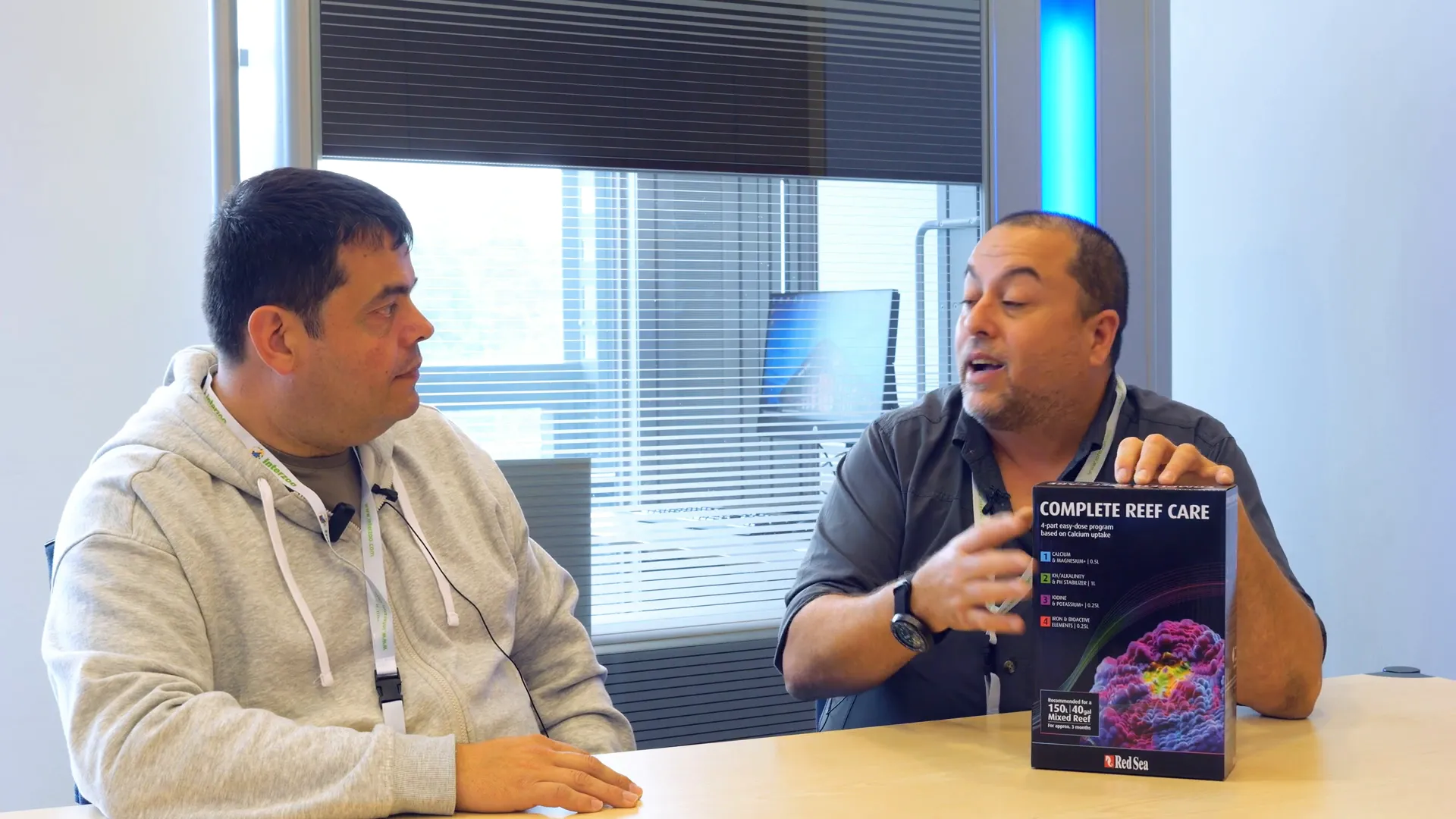Exploring the Red Sea: A Four-Part Guide to Coral Care
The Red Sea 4 Part Program revolutionises the way reef enthusiasts care for their aquariums, offering a scientifically-backed solution for optimal coral health. In this blog, we will delve into the insights shared by Dr. Sharon Ram, Red Sea's Chief Scientist, about this innovative program and its implications for reef aquarium maintenance.
Table of Contents
- Introduction to the Red Sea 4 Part Program
- Background of Coral Biogeochemistry Research
- The Importance of Accurate Aquarium Supplementation
- Understanding Coral Nutritional Needs
- The Role of Calcium and Trace Elements
- The Transition from 7 Part to 4 Part Program
- Chemical Precipitation in Coral Growth
- The Simplification of Dosing Solutions
- Calcium Testing vs ICP Testing
- The Impact of Refugiums on Element Consumption
- Automation and the Future of Dosing Systems
- Understanding Alkalinity in Reef Systems
- Transitioning from Other Brands to the 4 Part Program
- The Importance of Regular Water Changes
- Conclusion: The Path to Successful Coral Care
- FAQs about the Red Sea 4 Part Program
Introduction to the Red Sea 4 Part Program
The Red Sea 4 Part Program is a groundbreaking approach designed to enhance coral care in reef aquariums. This program is built on extensive research into coral biology and biochemistry, aiming to provide reef enthusiasts with an effective and efficient supplementation strategy. By focusing on the essential elements that corals require, this program simplifies the process of maintaining optimal water chemistry for coral health.
The Evolution of the Program
Initially, the program began as a seven-part supplementation regimen. However, through ongoing research and advancements in our understanding of coral needs, it has been streamlined into a more manageable four-part system. This transition not only makes it easier for hobbyists to implement but also ensures that corals receive precisely what they need for robust growth and vitality.

Background of Coral Biogeochemistry Research
Coral biogeochemistry is a field that explores the chemical processes within coral ecosystems. For over two decades, researchers have delved into how corals interact with their environment, particularly focusing on the incorporation of trace elements into coral tissue. Understanding these processes is crucial for developing effective supplementation methods that mimic natural conditions.
Key Findings in Coral Chemistry
- Corals require a specific set of 36 trace elements from the periodic table for essential biological processes.
- The uptake of calcium is directly linked to the incorporation of these trace elements, creating a balanced growth environment.
- Research indicates that the growth of soft tissue precedes skeletal growth, highlighting the need for a comprehensive understanding of these developmental stages.
The Importance of Accurate Aquarium Supplementation
Accurate supplementation is vital for maintaining a healthy aquarium. Many reef enthusiasts rely on standard test kits, which may not provide a complete picture of the water chemistry. This is where the Red Sea 4 Part Program shines, offering a scientifically based solution that caters specifically to the needs of corals.
Why Accurate Supplementation Matters
- Improves coral growth and health by ensuring all necessary elements are available.
- Reduces the risk of imbalances that can lead to coral stress or mortality.
- Enhances the overall stability of the aquarium ecosystem.

Understanding Coral Nutritional Needs
Corals are complex organisms that require a balanced diet of nutrients for optimal health. Their nutritional needs extend beyond basic elements; they also rely on a variety of trace elements and compounds for growth and development. Understanding these needs is essential for effective aquarium management.
Key Nutritional Components
- Calcium: Essential for skeletal formation, calcium is a cornerstone of coral health.
- Trace Elements: These elements play critical roles in biological processes, including photosynthesis and growth.
- Nitrogen and Phosphates: Important for building tissue and overall protein synthesis.

The Role of Calcium and Trace Elements
Calcium not only forms the structural backbone of coral skeletons but also influences the uptake of trace elements. This relationship is crucial for understanding how to effectively supplement aquariums to meet coral needs.
Calcium and Coral Growth
The process of calcium uptake is directly linked to the precipitation of aragonite, the mineral form of calcium carbonate that makes up coral skeletons. When corals take up calcium, trace elements are incorporated in a strict ratio, ensuring balanced growth.
- Calcium is the primary element for skeletal growth.
- Trace elements are absorbed in proportion to calcium, reflecting their necessity in the growth process.

The Transition from 7 Part to 4 Part Program
The shift from a seven-part to a four-part supplementation program was driven by the need for simplicity and efficiency. This transition allows aquarists to focus on the most critical components without the complexity of managing multiple supplements.
Benefits of the 4 Part Program
- Streamlined supplementation makes it easier for hobbyists to maintain optimal water conditions.
- Reduces the likelihood of errors in dosing and management.
- Enhances coral health by providing a balanced mix of essential nutrients.
By refining the supplementation process, the Red Sea 4 Part Program not only simplifies aquarium management but also promotes healthier, more resilient coral ecosystems. This advancement reflects a deeper understanding of coral biology and a commitment to supporting reef enthusiasts in their journey.
Chemical Precipitation in Coral Growth
Chemical precipitation plays a crucial role in the growth of corals, particularly in the formation of their skeletal structures. Corals primarily build their skeletons from calcium carbonate, which precipitates from seawater. This process is influenced by the availability of calcium ions and carbonate ions in the water.
When calcium ions combine with carbonate ions, they form calcium carbonate, resulting in the hard structures that corals need for support and protection. This precipitation is not just a simple reaction; it is dependent on various factors including pH, temperature, and the concentration of these ions in the water.
By understanding the conditions that promote optimal precipitation, aquarists can manipulate their systems to enhance coral growth. Maintaining stable water chemistry, particularly levels of calcium and alkalinity, is essential for ensuring that the precipitation process occurs efficiently.
Factors Affecting Precipitation
- pH Levels: Higher pH levels can increase the availability of carbonate ions, promoting calcium carbonate precipitation.
- Temperature: Warmer temperatures generally enhance metabolic processes in corals, leading to increased growth rates.
- Salinity: Consistent salinity levels help maintain the ionic balance necessary for effective precipitation.

The Simplification of Dosing Solutions
The Red Sea 4 Part Program simplifies the dosing of essential nutrients by combining trace elements into a single solution. This innovation not only streamlines the supplementation process but also ensures that the elements remain in a free form that can be readily absorbed by corals.
The traditional method of dosing multiple separate solutions can lead to complex interactions that may hinder absorption. By providing a balanced, concentrated solution, the program allows for more efficient nutrient uptake, reducing the risk of deficiencies or toxicities.
This simplification is particularly beneficial for hobbyists who may not have extensive knowledge of chemistry. With a single solution, the focus shifts from complicated dosing regimens to straightforward application, making coral care more accessible.
Advantages of Simplified Dosing
- Ease of Use: Hobbyists can easily manage their supplementation without needing advanced knowledge of chemistry.
- Improved Absorption: Free form elements are more readily absorbed by coral tissues, promoting better growth.
- Reduced Risk of Imbalances: A single, balanced solution minimizes the chances of overdosing or nutrient deficiencies.

Calcium Testing vs ICP Testing
Calcium testing remains a cornerstone of maintaining coral health. While ICP (Inductively Coupled Plasma) testing offers detailed analysis of water chemistry, it often complicates the understanding of essential nutrient levels.
The Red Sea 4 Part Program suggests that a simple calcium test can effectively indicate the overall health of trace elements in the aquarium. By monitoring calcium levels, aquarists can infer the status of other essential elements, ensuring that corals receive adequate nutrition.
While ICP testing provides a wealth of information, it can be overwhelming and may lead to misinterpretation of data. Understanding the interactions between elements is crucial, and this is where a straightforward calcium test excels.
Benefits of Calcium Testing
- Simplicity: Calcium tests are generally easier to perform and interpret compared to ICP tests.
- Cost-Effective: Regular calcium testing is more affordable than sending samples for ICP analysis.
- Holistic Insight: Calcium levels can reflect the overall balance of trace elements in the system.

The Impact of Refugiums on Element Consumption
Refugiums, or algae scrubbers, have become increasingly popular in reef aquariums for nutrient control. However, their introduction significantly alters the consumption rates of trace elements within the system.
Algae are known to consume trace elements at much higher rates than corals, which can lead to unexpected deficiencies if not monitored closely. This shift in consumption necessitates a reevaluation of dosing strategies when using refugiums.
For aquarists employing refugiums, it is advisable to follow a more detailed supplementation regimen, such as the seven-part system, to ensure that all essential nutrients remain balanced.
Key Considerations for Refugium Users
- Increased Element Demand: Be aware that algae will compete with corals for trace elements, potentially leading to deficiencies.
- Regular Monitoring: Frequent testing of water parameters is crucial to understand how nutrient levels fluctuate.
- Supplementation Adjustments: Be prepared to adjust dosing based on the specific needs of both corals and algae in the system.

Automation and the Future of Dosing Systems
Automation in dosing systems represents a significant advancement in aquarium management. The integration of automated systems allows for precise control over the supplementation process, reducing the potential for human error.
The Red Sea 4 Part Program is designed to work seamlessly with automated dosing systems, enabling hobbyists to maintain consistent water chemistry with minimal effort. This not only simplifies the management of supplements but also enhances the overall health of the coral ecosystem.
As technology continues to evolve, future dosing systems may incorporate even more sophisticated features, such as real-time monitoring and automated adjustments based on testing results.
The Advantages of Automated Dosing
- Precision: Automated systems can deliver exact amounts of supplements, ensuring consistent nutrient levels.
- Convenience: Reduces the time and effort required for manual dosing, allowing hobbyists to focus on other aspects of aquarium care.
- Data Tracking: Many automated systems can log data for monitoring trends over time, aiding in long-term aquarium management.

Understanding Alkalinity in Reef Systems
Alkalinity is a complex parameter in reef aquariums that encompasses more than just carbonate levels. It involves various components, including bicarbonate, borate, and other anions. Understanding alkalinity is essential for maintaining a stable environment for corals.
While many hobbyists focus on alkalinity as a single measurement, it is important to recognize that its components interact in various ways. For instance, the introduction of nutrients such as nitrate and phosphate can alter alkalinity levels, affecting overall coral health.
Regular monitoring of alkalinity, along with calcium levels, is recommended to ensure a balanced ecosystem. This holistic approach to water chemistry helps prevent potential imbalances that could lead to coral stress or mortality.
Key Aspects of Alkalinity
- Complex Interactions: Alkalinity is influenced by multiple elements, making it essential to consider the whole system.
- Regular Testing: Testing alkalinity once a week can help maintain stable conditions.
- Understanding Components: Knowledge of how different components affect alkalinity can inform better supplementation strategies.

Transitioning from Other Brands to the 4 Part Program
For aquarists currently using a seven-part supplementation system from other brands, transitioning to the Red Sea 4 Part Program is straightforward. The key is to start with the right foundation: the salt mix. This is essential for establishing a balanced environment in your aquarium.
When filling your aquarium for the first time, ensure that all components of alkalinity are in proper proportion. Once you have established a balanced condition, begin measuring calcium consumption. This measurement will guide you in gradually adjusting to the 4 Part Program.
In cases where hobbyists have refugiums, it is advisable to continue with the previous seven-part system until a clearer understanding of the new balancing needs is achieved. By understanding your aquarium's specific requirements, you can smoothly integrate the Red Sea 4 Part Program into your routine.

The Importance of Regular Water Changes
Regular water changes are a crucial aspect of maintaining a healthy reef aquarium. Over the years, both research and experience have shown that these changes significantly impact water quality and overall coral health. It's not merely about the chemical elements present in the salt mix; it's about the act of replacing water itself.
Water is composed of various molecules and radicals, which can change over time. By performing consistent water changes, you introduce fresh water that can replenish vital nutrients and remove harmful compounds. This practice is essential for maintaining a thriving aquatic ecosystem.
Whether you choose to do small weekly changes of 5-10% or larger monthly changes of 20-30%, the key is consistency. A well-established routine will pay dividends in coral health and vitality.

Conclusion: The Path to Successful Coral Care
In conclusion, achieving success in coral care hinges on a few critical practices. Consistent maintenance, using the Red Sea 4 Part Program, and regular water changes form the backbone of a healthy reef aquarium. These practices not only simplify the supplementation process but also enhance the overall stability of the ecosystem.
By continuously measuring calcium consumption and adhering to a structured maintenance routine, aquarists can ensure their corals receive all the necessary nutrients in a safe and effective manner. The journey of coral care is ongoing, but with the right tools and knowledge, hobbyists can create flourishing aquatic environments.

FAQs about the Red Sea 4 Part Program
What is the Red Sea 4 Part Program?
The Red Sea 4 Part Program is a streamlined supplementation system designed to provide corals with the essential nutrients they need for optimal growth and health. It simplifies the process of maintaining water chemistry in reef aquariums.
How do I transition from a different brand's system?
Begin by ensuring that your aquarium is balanced with the right salt mix. Measure your calcium consumption and gradually adjust to the 4 Part Program. If you have a refugium, continue using your previous system until you're comfortable making the switch.
Why are regular water changes important?
Regular water changes help maintain water quality by replenishing essential nutrients and removing harmful compounds. They play a vital role in the overall health of the aquarium ecosystem.
How often should I perform water changes?
Routine water changes can vary. You might choose to do smaller changes weekly (5-10%) or larger changes monthly (20-30%). The important factor is to maintain a consistent schedule.
What should I monitor when using the Red Sea 4 Part Program?
Regularly measure calcium levels and maintain a consistent supplementation routine. Monitoring these parameters will help ensure your corals receive adequate nutrients without the risk of overdosing.


























